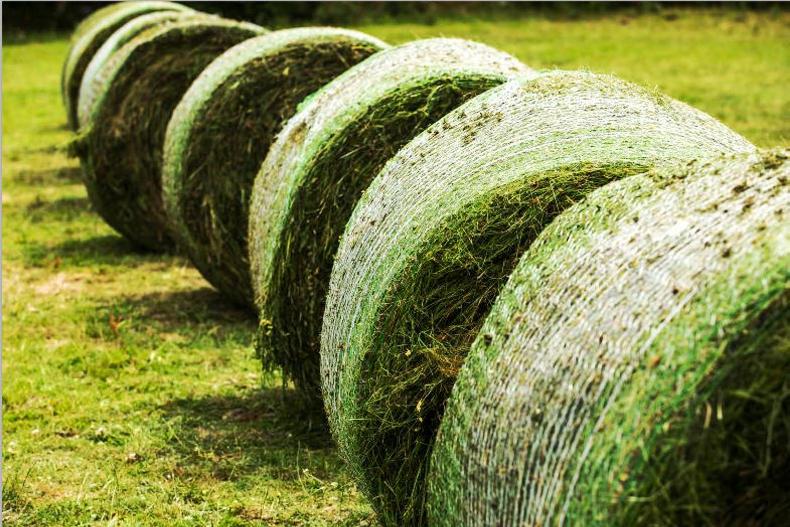In this final instalment of our series examining the fodder budgets from the 27 Teagasc/Irish Farmers Journal BETTER farm programme participants, we take a look at eight of the eastern participants. This week, we take a slightly different approach, as we examine the amount of fodder that has been conserved on farms since 1 August. The first fodder budgets were completed at the end of July and the beginning of August, the worst period on farms this summer as drought affected a vast number of farms and supplementation on grass reached its highest level.
As growth resumed in recent weeks, it is interesting to see the amount of fodder that has been conserved to make up the final winter requirements on farms. The bar chart included shows that on 1 August the average level of fodder on farms was just 79%. Now, just six weeks later, that figure is 93% and, before housing, the average is expected to be 102% of requirements.

Carlow
Looking at Tom Bolger’s fodder requirements, it can be seen that 213t DM is required to winter his suckler cows and young stock for a six-month winter. While he is currently fattening many of his steers and heifers for slaughter off grass, it is expected that 20 will have to spend some time in the shed before slaughter. As a result, the budget has allowed for 20 one- to two-year-old stock, which will be sold out of the shed at Christmas after a high-concentrate diet – hence the low 42t silage requirement.
Tom has possibly been one of the farmers worst affected by the drought. The free-draining nature of the land suffered severely as a result of the prolonged dry spell. Fodder conservation took a serious hit.
As can be seen from the chart, only 71% of requirements were in stock after the drought.
This came from 326t of pit silage, 50 silage bales and a combined 300 bales of hay and straw. With very little prospect of growth on the farm, the decision was made to purchase 200t of maize silage at a cost of €10,000. This will contribute a further 60t DM and send his requirements very near the green.
It is hoped that 35 more bales can be made before the winter to send his requirement figure above 100%. On buying the maize silage, Tom’s BETTER farm adviser Tommy Cox said it “guarantees Tom has enough fodder for the winter no matter what happens. Yes, it going to affect the bottom line significantly, but it allows him to sleep soundly at night now.”

Wicklow
Brian Doran has a requirement of 189t DM for this winter. Forty-seven suckler cows and 70 young stock will require 99t DM and 74t DM, respectively. Once again, the store finish system means approximately 30 steers and heifers will be housed for finishing at Christmas, after the main draft is sold off grass. This group of stock has a low 16t DM requirement.
Brian currently has 87% of these requirements in stock. On 1 August only 70% of requirements was in stock, made up of 332t of pit silage and 130 bales of silage. Because Brian has a tillage operation, he had the option to keep a lot of his own straw. Keeping 250 bales will contribute another 32t DM of fodder and will provide perfectly adequate feeding for his suckler cows in particular.
Before housing, it is expected that at least another 30 bales of silage can be made which would bring his stock to above 90% of requirements.

Kildare
Ricky Milligan can be satisfied with the level of fodder he has on his farm, particularly given the extent to which he suffered during the drought, just like on many free-draining farms in the east. There is currently 92% of requirements in the yard, and a further 30 bales can be conserved to come within touching distance of the requirements figure. The picture was not so pretty only six weeks ago, with only 50t DM in the pit and a further 83t DM made up of silage hay and straw bales, leaving him with just 76% of his requirements.
Since then, 89t of pit silage was made, bringing in a further 27t DM to the yard. Given the free-draining nature of the land on the farm in Robertstown, Kildare, the six-month requirement is not expected to be utilised but more to act as a buffer to prevent against the worst-case scenario. Earlier this year, when the Irish Farmers Journal visited Ricky, he explained that his use of the Hereford breed was mainly down to the fact that they are an early maturing animal meaning the majority can be sold off grass, avoiding housing for a second winter. This strategy is making a massive saving on the fodder budget, with only 15 lighter steers and heifers expected to be housed for finishing.

Louth
Martin O’Hare is running a split-calving herd near Dundalk in Co Louth. Eighty-three suckler cows and 16 in-calf heifers will require a combined 200t DM for a six-month winter. Again, it is hoped supplies for six months will not be needed. Forty-three weanling heifers will require 45t DM overall, while the same number of weanling bulls destined for under-16-month slaughter require less than half of this, due to a high-level of concentrates being included in the diet.
At first glance, the fodder situation on Martin’s farm looks quite bleak.
At present, there is only 77% of requirements in the yard stemming from 150t DM of pit silage, 22t DM of wrapped silage, 12t DM from a GLAS catch crop and 35t DM of straw from 275 bales of straw he kept from his tillage enterprise. However, to make up this shortfall, 53ac of second-cut will be put into the pit.
This ground had to be grazed during the drought but was since taken up and fertilised and is expected to bring in 80t DM, or 6t fresh weight per acre. Locals and followers of the BETTER farm programme will be able to hear about how Martin has dealt with fodder on his farm at the final BETTER farm autumn walk taking place on his farm Thursday at 2pm.

Kilkenny
Michael McDonald has only 63% of his 285t DM fodder requirement at present. A planned cut of 230 bales of silage is expected to deliver another 65t DM, which would bring his requirement figure to 86%. Currently, the 63% figure is made up of 505 silage bales and 20ac of Redstart, which will provide approximately 16t DM. It is critical for Michael to get enough fodder into the yard before the winter because little can be done to lower the overall demand.
As Michael is autumn-calving, suckler cows can’t be restricted below the 1.4t/head/month requirement, unless meals are introduced. Furthermore, it was originally planned to house 47 one- to two-year-old stock, a mix off 27 breeding heifers and 20 beef heifers. However, the latter group of stock might be sold off grass, if sufficient stocks can’t be made before winter. This decision hangs in the balance.

Meath
Co Meath farmer Joe Healy has 109% of his requirements in the yard at present and no more fodder will be cut between now and winter and all available grass will be grazed for as long into the autumn and winter as conditions allow. Because Joe is calving in April and May predominantly, cows are suckling at housing and weaning takes place halfway through the winter. With this in mind, cows can’t be restricted for the first half of the winter and calves will need high-quality feeding before, during and after weaning.
A total demand for the winter of 262t is made up predominantly of 230t DM requirement for 72 cows and their calves. The balance of 32t DM is needed for 12 breeding heifers and 40 bulls which Joe buys in as weanlings and slaughters under 16-months in a winter-finishing system.
On 1 August, Joe had only 84% of requirements in the yard, coming from 363t of pit silage, 165 bales of silage, 210 bales of purchased hay and 120 bales of feeding straw. Since then, a further 66t DM of silage has been gathered in the form of 234 bales which have helped Joe to cross the 100% requirement target.

Wexford
On 1 August, Peter and Cathal Breen had 100% of their fodder requirements in the yard. Now they have 129% of requirements. The farm’s overall fodder requirement is 234t DM for 175 head of cattle. Sixty-five suckler cows will need 137t DM, 60 weanlings will eat 63t DM, 20 one- to two-year-olds will require 20t DM and the 30 beef bulls, which were originally planned to be slaughtered as steers at a later date, will need only 14t DM.
To try meet these requirements, the Breens will use a combination of silage, hay and straw predominantly. In terms of silage, there is 140t DM of pit silage and 75t DM of bales, 64t DM of which was made since completing the first fodder budget on 1 August. Hay will also be used this winter, particularly in the diet of dry suckler cows and 274 bales of hay are now available in the yard, all of which were made during the dry weather in the summer. Finally, 200 bales of straw are available for both feeding and bedding and these were kept from Peter and Cathal’s own tillage crops. From the tillage crops, there is also 45t of barley which will be kept and max treated for feeding to weanlings.

Laois
Unfortunately for Harry and Joe Lalor, there is less fodder in the yard now than there was at the start of August. Due to the high stocking rate on the farm, an estimated 31t of silage and 215 bales were fed out to make up for the shortage of grass on the farm.
On 1 August, there was 90% of requirements on the farm, now there is just 85%. However, this figure is expected to climb back up to just below 90% once again with the planned cutting of 60 bales. The Lalors have 330 head of cattle to feed on the farm, which will require just short of 450t DM over the course of a six-month winter. There are also 300 sheep on the farm. However, these will be grazed on 13ac of Redstart for the majority of the winter period. In the budget is 157t DM of pit silage, 285 bales of silage, 120 hay bales, 145 bales of straw and 95t DM of fodder beet.
Given the free-draining nature of the ground, it is not expected that the winter will last six months and for every week that the winter is below six-months, it reduces requirement by 18t DM or 4%. With this in mind, the Lalors will have to monitor the situation but they won’t need to panic over the deficit just yet.






 This is a subscriber-only article
This is a subscriber-only article









SHARING OPTIONS: